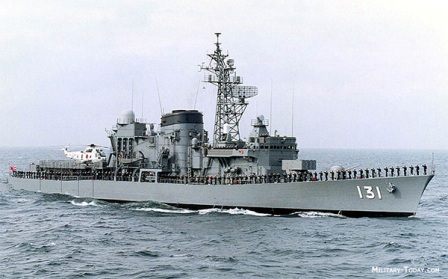Hatsuyuki-class
Summary
| Origin country | 🇯🇵 Japan |
| Category | Destroyer |
| Subtype | ASM destroyer |
| Manufacturer | Hitachi Zosen Corporation, IHI Corporation, Sumitomo Heavy Industries, Mitsubishi Heavy Industries, Mitsui Engineering & Shipbuilding |
| Year commissioned | 1980 |
| Units | 122 HATSUYUKI, 123 SHIRAYUKI, 124 MINEYUKI, 125 SAWAYUKI, 126 HAMAYUKI, 127 ISOYUKI, 128 HARUYUKI, 129 YAMAYUKI, 130 MATSUYUKI, 131 SETOYUKI, 132 ASAYUKI, 133 SHIMAYUKI |
Description
The Hatsuyuki-class destroyer is a significant class of destroyer within the Japan Maritime Self-Defense Force (JMSDF). Developed as the first generation of general-purpose destroyers, it represented a strategic shift in response to evolving maritime threats, particularly from the enhancement of the Soviet submarine fleet and the reinforcement of anti-ship missiles in the 1970s. This adaptation led to a new destroyer concept that integrated both anti-air and anti-submarine capabilities alongside missile and helicopter operation. By combining the functionalities of the anti-aircraft gunfire-oriented and ASW-oriented destroyers, a more versatile warship was born.
These destroyers have a shelter deck style influenced by the earlier Isuzu class, with a truncated long forecastle design, and their underwater hull design takes after the JDS Amatsukaze. Notably, they incorporated noise reduction features, such as the Prairie-Masker from the third ship onwards, with refurbishments made for earlier ships. Design modifications on later ships included substituting steel for aluminium in parts of the superstructure, therefore increasing durability at the expense of displacement and maneuverability.
A prime feature of the Hatsuyuki-class was the introduction of a combined gas or gas (COGOG) propulsion system, a first for the JMSDF, using gas turbines provided by Kawasaki-Rolls-Royce for both cruising and high-speed operation. This design was akin to the British Royal Navy's Type 21 frigates, although it consequently lacked an alternating engine room arrangement, a standard in past JMSDF destroyers, thus raising concerns regarding redundancy.
Operational systems onboard include the OYQ-5 Tactical Data Processing System, the Japanese Sea Sparrow Improved basic point defense missile system, a FCS-2 fire-control system, and an OTO Melara 76 mm compact gun. Additionally, they are equipped with Boeing Harpoon missiles for surface combat. The ships also featured a compact aviation deck that allows for operation of the Mitsubishi HSS-2B and later the SH-60J helicopters, though with compromised data link capabilities due to space constraints. Furthermore, the class was initially equipped for passive sonar operations, later upgraded with towed array sonar systems on select vessels.
Technical specifications
| Hatsuyuki | |
|---|---|
| Displacement | 3700 tons |
| Crew | 200 members |
| Width | 13.6 m (44.6 ft) |
| Length | 130.0 m (426.5 ft) |
| Propulsion | 2 Rolls Royce TM-3 Olympus gas turbines with a power of 54,000 hp each - 2 propellers |
| Armament | 8 UGM-84 (IV 2) + 1 Mk.29 Sea Sparrow (18 missiles) + 1 76mm OTO-Melara Compact gun + 2 CIWS Mk.15 Phalanx + 1 ASROC + 6 T/ASM Mk.68 + 1 SH-60 LAMPS III helicopter |
| Maximum speed | 30 knots |
Photo of Hatsuyuki class
